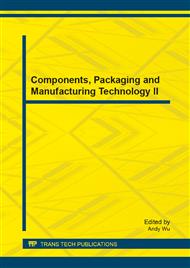p.47
p.50
p.56
p.63
p.70
p.75
p.80
p.86
p.92
Impacts of Solder Voids on Power Devices' Thermal Characteristics
Abstract:
Thermal performance is very important to power devices. Solder voids are detrimental to power devices thermal and reliability characteristics. According to above-mentioned problem, using computer software as an analysis tool, making some simulation and modeling on the influence of different solder voids distribution to power devices thermal characteristics. Focus on the solder voids around active region of power devices. Computing results show that solder voids under active region are the most evidently factor to power devices thermal characteristics and provide some suggests on the process of power devices thermal design.
Info:
Periodical:
Pages:
70-74
Citation:
Online since:
February 2014
Authors:
Price:
Сopyright:
© 2014 Trans Tech Publications Ltd. All Rights Reserved
Share:
Citation:


